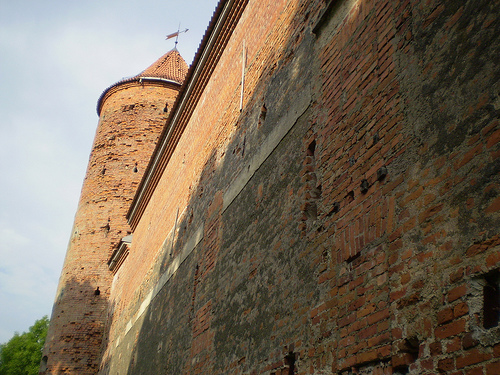

Location: Jurbarkas district Map
Constructed: 1604- 1610
Panemune Castle located on the right bank of the Nemunas river in Jurbarkas district was constructed between years 1604 and 1610. It replaces an older citadel that was erected here in the middle 14th century by the Teutonic Knights that were set to conquer Lithuanian lands inhabited by pagan tribes. Unlike former fortress Panemune Castle was not intended as a defensive fortification. Its architecture might look menacing, but it is more of stylization to the romantic age of the Medieval times. The castle underwent massive reconstruction in 1759 by Gielgud family.
In 1597 The manor of Stanislaus Stankevičiaus-Bielevičiaus Panemune,
a chamberlain from Žemaica, was purchased by a landowner of Hungarian
origin, forest merchant Jonušas Eperješas. He in 1604 began building a
Renaissance residential castle. It is believed that the architect of the
building is Petras Nonhartas (German: Peter Nonhardt), the author of the
reconstruction of the Lower Castle of Vilnius. The construction of the
castle was completed in 1610, but later it was remodeled several times.
Vytėnai Castle in 1753 was sold to Leon Igelstrom, who in 1759
handed it over to Akmenė's elder, LDK flag bearer Antanas Gelgaudus. The
new owner reconstructed the abandoned castle, cultivated the park and
established a luxurious representative residence for his family. The
reconstructed castle acquired features of classicism, the ponds were
renewed in this style, the park was arranged, an orangery was installed
in it, enclosures for fallow deer. In the southern part of the building,
through the cut-out windows, a beautiful view of the manor park and the
Nemunas opened up. Cylindrical furnaces made of white bricks were also
built, representative rooms are decorated with friezes of antique
figures. The castle became the luxurious residence of A. Gelgaudas.
General Antanas Gelgaudas became the chief in 1831. leader of the
rebellion in Lithuania. After arriving from Užnemunė, he came with 16
thousand soldiers moved across the Nemunas at Gelgaudiškis and stayed
near their homeland. This is where the rebel fights in Lithuania
started. After losing in 1831 After the uprising and the death of A.
Gelgaudas, the castle was abandoned, the valuable library was taken
away, the castle was expropriated (A. Gedgaudas himself was declared a
"first degree state criminal"). Having lost its owners, the castle was
poorly maintained and gradually fell into disrepair over time.
in
1867 the castle and the manor were taken over by the owner Stanislovas
Puslovskis, the heir of the Gelgaudai estate, from the Valdinė ward. The
castle has several rooms, but the eastern part has almost collapsed. in
1903 Russian painter Nikolai Roerich visited the castle when he and his
wife Jelena were traveling on the Nemunas.
in 1925 the castle and
manor were expropriated by the state of Lithuania, they were sold at
auction to priest Antanas Petraičius (1861–1933) who came from the USA,
who died soon after. Between the wars, a monastery of Salesian monks
operated here, which was closed during the Second World War. in 1934 the
ruins of the castle, destroyed in 1927 fire, proposed to be taken over
by the Department of Culture of the Ministry of Education, and in 1935
it was transferred to the Archaeological Commission of the Ministry of
Education (estimated at 40 thousand litas). Since then, the castle has
been at the disposal of various cultural and educational institutions.
1939, 1959-1962 the castle was conserved in 1984. and 1995-1997 is
being restored. in 1961 included in the list of Lithuanian architectural
monuments.
in 2009 the castle is being rebuilt, it is planned to
restore the former appearance of the castle - two demolished defensive
towers and one of the castle's hulls are being rebuilt, thus the former
structure of the castle with a closed courtyard will be restored. It is
planned to plaster the facades, replace roof coverings and windows. The
project is financed by the EU structural fund. The project will be
developed in three phases, each phase may last approximately three
years.